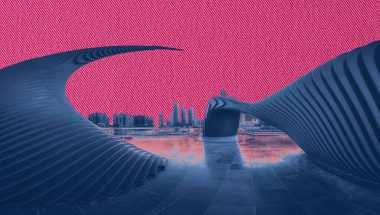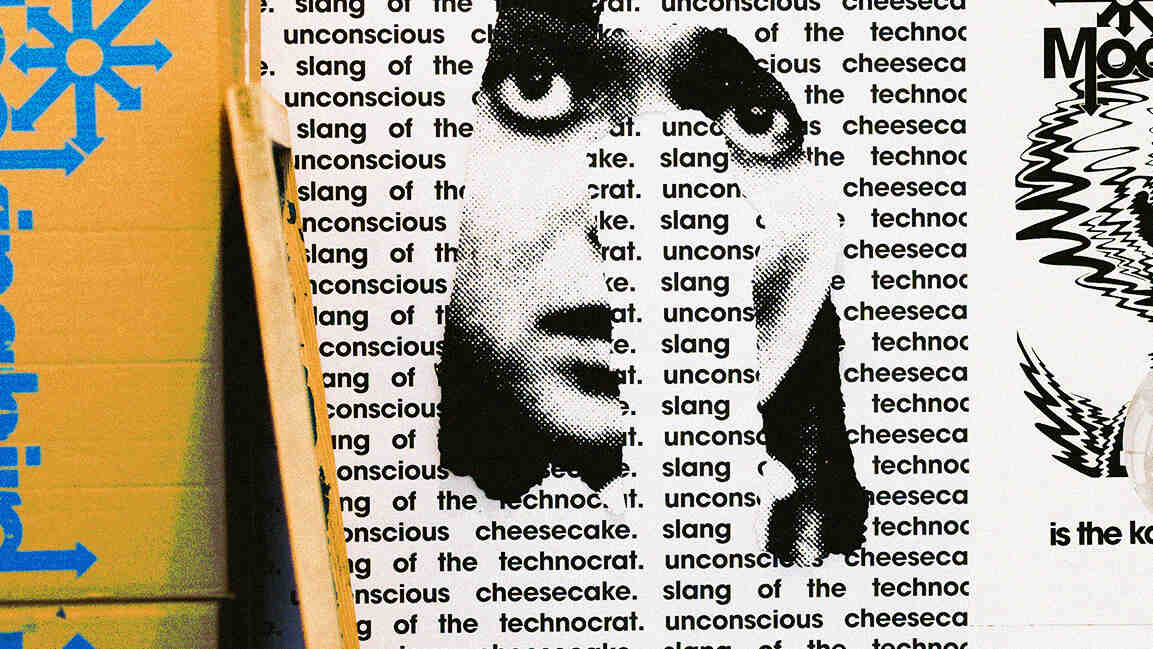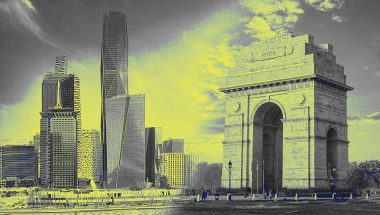- | 1:00 pm
Stitch by stitch: These architects weave Bahrain’s ecological heritage
Through local materials and collective making, Maraj is reimagining design as a tool for preservation and storytelling.

For Bahrain-based architects Latifa Alkhayat and Maryam Aljomairi, architecture isn’t just about constructing spaces; it’s about recovering the stories that inhabit them. Their design platform, Maraj, translates cultural memory into material form, blending technology, craft, and anthropology into a practice that challenges the boundaries of what architecture can be.
Their latest work, Stories of the Isle and the Inlet, the winning commission for Abwab 2025 at Dubai Design Week, is both a tactile archive and a spatial narrative. Through a textile installation that depicts the flora, fauna, and ecological histories of Nabih Saleh, a small Bahraini island tucked between Tubli’s wetlands and Sitra’s industrial belt, Maraj transforms embroidery into a form of architectural storytelling.
“This work began as a response to Abwab’s theme of ornamentation,” Alkhayat says. “It’s a chance to work with embroidery at an architectural scale. But we wanted our ornamentation to be rooted in Bahrain—not to repeat what exists, but to create our own form of ornamentation that contributes to the larger history of the region.”
What began as a conceptual challenge evolved into an act of cultural preservation. “We chose Nabih Saleh as our starting point,” she says. “It’s an island surrounded by myth and memory. People spoke of it so fondly: of natural springs, date palms, and birds migrating through the bay. Yet, we realized that these stories only existed orally. They weren’t documented or archived anywhere.”
THE LANGUAGE OF EMBROIDERY AS ENVIRONMENTAL DATA
Maraj’s response was to transform oral histories into stitched data. Sourcing materials locally and working with Bahraini embroiderers and tailors, the studio designed a textile enclosure inspired by thob al nashil, a traditional mesh garment interwoven with metallic threads. Through intricate embroidery, they inscribed species, myths, and ecological systems onto layered textile walls that shimmer with detail.
“For us, ornament became a way of recording memories,” says Alkhayat. “Historically, you’d find poetry or stories inscribed in architecture; details that spoke of what people were thinking or feeling at the time. Our embroidery continues that tradition. It’s a form of inscription that records a landscape’s living memory.”
The central panel depicts Nabih Saleh’s mangroves “like guardians of the shoreline,” as Alkhayat puts it, while surrounding surfaces trace the bay’s wildlife and the marks of human intervention: fishing nets, dredging machinery, and sewage discharge. “We read reports, mapped every species, and drew them in detail,” she says. “We wanted the ornament to be rooted in this place, in its ecology and its lore.”
Even the island’s legends find form in thread. “One story says that anyone who takes from Nabih Saleh meets misfortune,” she adds. “So in the embroidery, you’ll see boats approaching and then capsizing. It’s a quiet reminder that you should behave like the birds who pass through empty-handed.”
COLLABORATION, CRAFT, AND THE CHALLENGE OF SCALE
To create Stories of the Isle and the Inlet, Maraj collaborated with multiple embroidery workshops scattered across Bahrain, often hidden within homes and small neighborhoods. “It was challenging to convince them to do something this big,” Alkhayat recalls. “Some were skeptical, not because of money, but because of trust and continuity. There’s a culture of loyalty between embroiderers and their clients. They have long-term relationships, and we were newcomers.”
Building trust requires presence. “We had to visit daily, sometimes take the fabric home, trace drawings by hand, and return them to make things easier,” she says. “Working at this scale was completely new for them. The fabric took over the entire shop.”
Technical surprises abounded. “We didn’t realize how embroidery behaves,” Alkhayat admits. “When you stitch densely, the fabric wrinkles. Or lines you expect to meet perfectly just won’t. We come from an architectural background where precision is everything—but embroidery has its own grain, its own movement. It’s very human. We learned to let go of perfection.”
The result is a textile architecture composed of five panels, each created by a different embroiderer, with subtle variations in design. “No one’s noticed this, but there are so many glitches,” she laughs. “It’s beautiful that way. It’s a collective work, stitched by many hands and perspectives.”
THE FUTURE OF DESIGN
Abwab’s 2025 theme, In the Details, celebrates ornamentalism as a language of embedded meaning. Maraj’s project aligns perfectly, demonstrating that ornament can be a vessel for knowledge, ecology, and collective memory.
“When you work with fabric like this, you realize it’s not just decoration,” says Alkhayat. “Each stitch is a story. Even if it’s made by a machine, it takes time, care, and understanding. We could have printed everything, but we didn’t. We wanted the depth, the reflection, the texture that only thread can bring. Embroidery is data made tangible.”
The process also evolved into a form of environmental activism. “We wanted to ask how design can record things that aren’t just written or archived,” Alkhayat explains. “This installation is about making memory visible [and] bringing people back to places they’ve forgotten. When someone steps inside and says, ‘I feel like I’m in a dream,’ we know we’ve done something right.”
Beyond the installation, the project raises questions about the balance between development and preservation. “If we continue reclaiming land without leaving intertidal zones, species lose their homes,” Alkhayat warns. “We need to design landscapes that step and slope gently, allowing life to coexist. Architecture should be an ally to ecosystems, not their eraser.”
A MOVEMENT, ROOTED IN PLACE
Maraj’s work reflects a growing trend in global design research, where storytelling, participation, and material experimentation converge. In an era dominated by digital rendering and speed, Stories of the Isle and the Inlet is slow, layered, and local.
“As architects, we’re trained to seek perfection,” Alkhayat reflects. “But through this process, we learned that imperfection is a form of intelligence. The fabric moves, the machines jam, the stitches vary, and that’s what makes it alive.”
In Stories of the Isle and the Inlet, memory becomes matter, and ornament becomes a site of resistance. It’s an installation that doesn’t just depict a landscape, it reimagines how we can live with it, learn from it, and listen to it.
“We see fabric as a field tool,” says Alkhayat. “It records the island’s rhythms, its water, its flora, its people, in ways that architectural drawings cannot.”







































